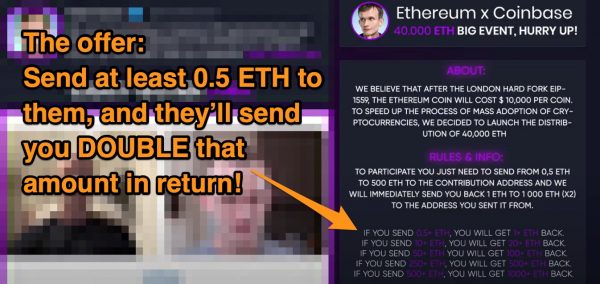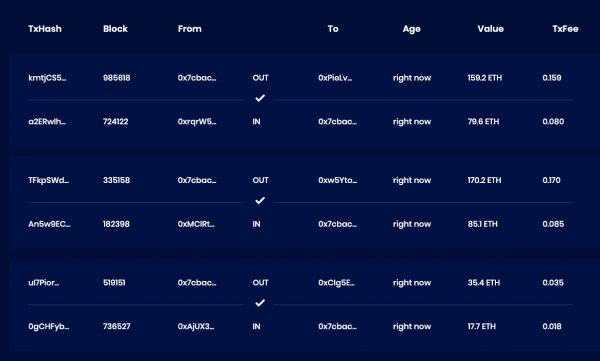If you’re someone who regularly watches cryptocurrency talking heads on YouTube, the algorithm probably suggested that you watch the video shown in the screenshot below:
It’s a scam.
I’ll explain below.
The “live” interview is a year old
For starters, the video, which purports to be a live interview with Ethereum creator (and son of one of my contacts from my Toronto days) Vitalik Buterin, is actually a “live” rebroadcast of an actual Coinbase video from last November:
That year-old video is embedded in coin-ether.net’s video to give it an air of legitimacy in the hopes that you’ll suspend your critical thinking and fall for their “giveaway” offer:
Here’s the “giveaway”: Send at least 0.5 ETH (US $4203.30 as I write this) to their wallet address, and they’ll immediately send double that amount to your wallet. And in case you don’t know what “times two” means, they explain it to you very clearly:
- If you send 0.5+ ETH, you will get 1+ ETH back.
- If you send 10+ ETH, you will get 20+ ETH back.
- If you send 50+ ETH, you will get 100+ ETH back.
- If you send 250+ ETH, you will get 500+ ETH back.
- If you send 500+ ETH, you will get 1000+ ETH back.
This is a psychological trick: it’s all about getting you to think of all that sweet Ethereum that could be sitting in your wallet — if you’d just point your browser at coin-ether.net and send them your ETH!
WHOIS coin-ether.net?

If you do a WHOIS on the domain coin-ether.net, you’ll get these tidbits of information that should trigger your “scammy sense”:
- Created on 2021-10-30
- Expires on 2022-10-30
- Updated on 2021-10-30
That’s right — this domain was born yesterday (at the time of writing), and its owners are hoping you were born yesterday, too!
coin-ether.net’s maps to the IP address 185.178.208.138, which is located in Rostov Oblast, located in the Southern Federal District of Russia.
The display of Ethereum transfers is randomly generated
If you go to coin-ether.net and scroll to the bottom of the page, you’ll see a constantly-updated table of transfers that purport to show people sending them some ETH and then getting double that amount in return.
It’s fake.
A simple “view source” of coin-ether.net’s home page shows that one of its imported scripts is something called table.js.
If you view the source of table.js, you’ll find that its purpose is to repeatedly call a function named createTableItem(), which creates tables containing randomly-generated Ethereum addresses and amounts in exchanges that always happen “right now”:
const createTableItem = () => {
let inputValue = randomInteger(1, 100) + "." + randomString(1, "123456789");
let outputValue = ++inputValue * 2;
let txFIn = inputValue / 1000;
let txFOut = outputValue / 1000;
let cutWallet = BaseWallet.slice(0, 7) + "..."
let item = document.createElement("div");
item.className = "table_item ";
item.innerHTML = `<table>
<tr class="table_item-top">
<td>${randomString(7) + "..."}</td>
<td>${randomString(6, "123456789")}</td>
<td>${cutWallet}</td>
<td>OUT</td>
<td>${"0x" + randomString(5) + "..."}</td>
<td>right now</td>
<td>${outputValue + " ETH"}</td>
<td>${txFOut.toFixed(3)}</td>
</tr>
<tr class="table_item-apply">
<td class="left"></td>
<td ><img src="./images/Apply.png" alt="apply" /></td>
<td class="right"></td>
</tr>
<tr class="table_item-bottom">
<td>${randomString(7) + "..."}</td>
<td>${randomString(6, "123456789")}</td>
<td>${"0x" + randomString(5) + "..."}</td>
<td> IN</td>
<td>${cutWallet}</td>
<td>right now</td>
<td>${inputValue + " ETH"}</td>
<td>${txFIn.toFixed(3)}</td>
</tr>
</table>`;
var first = table.childNodes[0];
let last = table.lastChild;
table.insertBefore(item, first);
let itemsCount = table.children.length;
if (itemsCount > 3) {
table.removeChild(last);
}
};They didn’t hide it very well — even a student in their first week of a coding bootcamp would be able to find it.
And finally, there’s just plain common sense

Why would anyone simply give you double the money you give them?

There’s a lot of opportunity in crypto, but coin-ether.net ain’t it. Don’t fall for the scam!



11 replies on “Coin-ether.net’s YouTube scam to con you out of your Ethereum”
[…] the algorithm probably suggested that you watch coin-ether.net’s video. It’s a scam, and I explain all in this article, which includes things such […]
[…] algorithm probably suggested that you watch coin-ether.net’s video. It’s a scam, and I explain all in this article, which includes things such […]
[…] the algorithm probably suggested that you watch coin-ether.net’s video. It’s a scam, and I explain all in this article, which includes things such […]
[…] the algorithm probably suggested that you watch coin-ether.net’s video. It’s a scam, and I explain all in this article, which includes things such […]
[…] algorithm probably suggested that you watch the video from coin-ether.net. It’s a scam and I explain everything in this article, which includes such things […]
[…] in all probability prompt that you simply watch coin-ether.web’s video. It’s a rip-off, and I explain all in this article, which incorporates issues equivalent […]
[…] in all probability urged that you just watch coin-ether.internet’s video. It’s a rip-off, and I explain all in this article, which incorporates issues corresponding […]
[…] the algorithm probably suggested that you watch coin-ether.net’s video. It’s a scam, and I explain all in this article, which includes things such […]
I already fell for this, unfortunately. Do you know any legit fraud specialists who might be able to recover my stolen Ethereum?
Thanks
Hey, Alex:
That’s going to be tricky. Cryptocurrency transfers, once completed can’t be reversed unless you get the other side to agree to send your coins back.
Further complicating the matter is the fact that they people behind coin-ether.net are based in Russia, or at least their server is, according to their DNS records.
You can try to contact your cryptocurrency exchange and see what they can do.
There are also investigators who specialize in this sort of scam, but their services can be costly — do this only if the amount you lost is more than the investigator’s charge.
— Joey
[…] This is pretty much the same scam as one pulled last month with a fake “double your ETH” offer. Read it first, then note the similarities below. […]